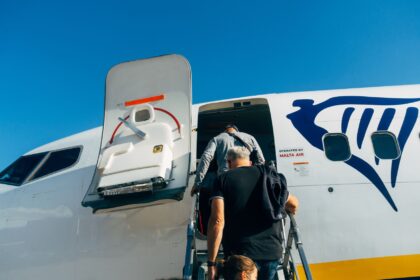Introduction
Traveling abroad with young children can feel like a Herculean task. You’ve got tantrums to manage, unpredictable sleep schedules, and the constant fear of forgetting something crucial. But here’s the thing: it’s also one of the most rewarding experiences you can give your family. Exposing kids to different cultures, languages, and landscapes broadens their little horizons in ways that no textbook ever could. Plus, you’ll be making core memories together that last a lifetime.
Now, it’s not all sunshine and gelato. The road (or flight path) to a smooth international family vacation is paved with planning, patience, and practicality. From selecting the right destination to navigating jet lag like a ninja, this guide will walk you through every step of how to travel abroad with young children, without losing your sanity.
So grab your coffee, bookmark this page, and get ready. Whether it’s your first time flying internationally with your toddler or you’re a seasoned travel parent looking for a smoother ride, this is the playbook you’ve been waiting for.
Planning Ahead: The Key To A Stress-Free Trip
Choosing The Right Destination
Your dream of sipping margaritas in a rustic beach hut might need tweaking when you’ve got a three-year-old in tow. The best international destinations for families with young children are those that blend adventure with accessibility. Think safety, good healthcare systems, clean environments, and family-friendly amenities.
Start by asking yourself a few questions:
- Is the destination stroller-friendly?
- Are there enough indoor/outdoor activities for young kids?
- Is the local food something your child might actually eat?
Look into countries known for being child-friendly—places like Japan, Canada, Australia, and many parts of Europe (hello, Scandinavia!) often top the list. They have excellent infrastructure, friendly locals, and a range of activities that cater to children.
Avoid destinations with extreme climates, political instability, or health concerns like mosquito-borne illnesses. You want less stress, not more.
Timing Your Trip Wisely
If your little one thrives on routines (and whose doesn’t?), timing can make or break your trip. The best time to travel abroad with young children is during shoulder seasons—spring and fall. These periods offer fewer crowds, milder weather, and lower costs.
Also, think about the time of day you travel. Red-eye flights might help your child sleep through the trip, while daytime flights can mean hours of needing entertainment. Know your child and plan accordingly.
Avoid school holidays if you can—airports are packed, prices skyrocket, and attractions become chaotic.
Booking Family-Friendly Accommodations
A luxury hotel with no elevator and paper-thin walls? No thanks. When booking accommodations abroad, prioritize practicality and comfort over Instagram appeal. Look for places that specifically advertise themselves as family-friendly.
Here’s what to consider:
- Rooms with kitchenettes for prepping meals
- Laundry facilities (because blowouts happen)
- Cribs or rollaway beds are available
- Proximity to attractions and public transport
- Quiet surroundings for nap time
Vacation rentals (like Airbnb or Vrbo) are often better than hotels when traveling with kids. You get space to spread out, a home-like feel, and usually a better shot at a good night’s sleep.
Preparing Documents and Travel Requirements
Passports and Visas for Children
A shocking number of parents find out too late that even newborns need a passport to travel internationally. So, rule number one: start early. Passport processing can take weeks or even months, depending on where you live and the time of year.
To apply for a child’s passport, you’ll typically need:
- Birth certificate
- Parent/guardian identification
- Consent from both parents (if applicable)
- A passport photo that meets strict criteria
Make sure the passport is valid for at least 6 months after your planned return date—many countries won’t let you in otherwise.
As for visas, requirements vary by destination. Check government websites or use online tools to see if your child needs a tourist visa, and how to get it.
Travel Insurance Essentials
Travel insurance isn’t just a “nice-to-have” when kids are involved—it’s essential. From unexpected illnesses to trip cancellations, you want full coverage that includes:
- Medical emergencies and hospital stays
- Lost or stolen luggage (especially those favorite stuffed animals!)
- Trip delays or interruptions
- Evacuation coverage in extreme situations
Read the fine print. Some policies exclude pre-existing conditions or have low reimbursement caps. It’s worth paying a little more for peace of mind.
Health and Vaccination Requirements
Before you board that plane, check with your pediatrician about destination-specific health risks and vaccines. Some countries require proof of certain immunizations, like yellow fever or COVID-19 shots.
Also, ask for a travel health kit:
- Infant or child-safe pain relievers
- Anti-nausea medicine
- Fever reducers
- Electrolyte powder
- Prescription meds (if needed) with doctor’s note
Don’t forget to ask about altitude sickness, water safety, and how to handle stomach bugs abroad. Prevention is your best friend when you’re far from home.
Packing Like a Pro
Must-Have Items for Kids
Packing for young children feels like prepping for a survival mission. You don’t want to overpack, but forgetting essentials can quickly spiral into chaos.
Here’s a no-fail packing list:
- Diapers and wipes (more than you think!)
- Child’s passport and documents
- Medications and a health kit
- Favorite comfort toy or blanket
- Portable changing mat
- Baby carrier or lightweight stroller
- Sippy cups and snacks
- Spare clothes (for both kids and parents)
Make a checklist well in advance and tick things off as you go. Don’t assume you can buy everything at your destination—brands and availability vary greatly around the world.
Keeping It Light and Functional
Overpacking is the number one rookie mistake. Try to fit everything into one suitcase and one carry-on per parent. Use packing cubes, roll your clothes, and choose items that serve multiple purposes (like a sarong that doubles as a blanket or a towel).
Opt for travel-sized containers, collapsible baby gear, and clothing that’s easy to wash and quick to dry. And remember: laundry is usually an option abroad.
Snacks, Toys, and Entertainment
If you want peace on the plane or during long sightseeing days, you’ll need an arsenal of snacks and distractions.
Snacks should be:
- Non-messy (think crackers, cheese sticks, fruit pouches)
- Easy to store and grab on the go
- Familiar to your child (no new flavors in-flight!)
For toys and entertainment, bring a mix of:
- Coloring books and crayons
- Sticker books
- Small figurines or puzzles
- Pre-loaded tablets with kid shows and apps
- Headphones that fit little ears
Rotate the toys throughout the trip to keep them exciting. And always keep a few surprises in your carry-on for meltdowns-in-the-making.
Airport Strategies for Smooth Travel
Early Arrival and Check-In Tips
When traveling with young children, arriving at the airport early isn’t just smart—it’s survival. Kids slow things down. A lot. From security lines to unexpected diaper changes, everything takes longer. Aim to arrive at least 2.5 to 3 hours before an international flight. This gives you a buffer for all those “just in case” moments.
Choose online check-in if available; it minimizes wait time and lets you select seats in advance. Pro tip: book seats near the aisle for quick bathroom access or the bulkhead for extra legroom. Some airlines offer family check-in lanes or pre-boarding for those with kids, which can be a lifesaver when juggling gear and little humans.
Also, wear your baby in a carrier if possible. It leaves your hands free and helps you breeze through security without needing to unpack a stroller. And don’t forget to label your stroller and car seat for gate-checking.
Navigating Security With Children
Security checks can be one of the most frustrating parts of flying with kids. To make it smoother:
- Pack all liquids and baby food in a clear zip-lock bag
- Be ready to take the electronics and baby bottles out
- Kids under 12 don’t need to remove their shoes, but parents do
Explain the process to older toddlers in advance—it helps ease fear and resistance. And remember, TSA agents aren’t there to ruin your trip. A polite, patient attitude goes a long way.
Bring a folder with all important documents: passports, boarding passes, vaccination records, and insurance cards. Having everything in one place speeds things up and keeps you organized under pressure.
Airport Amenities That Help Parents
Airports have come a long way when it comes to helping families. Many now offer family restrooms, nursing pods, play zones, and even stroller rental services.
Here’s what to look out for:
- Children’s play areas: Great for letting off steam before the flight
- Baby care rooms: Perfect for quiet nursing or diaper changes
- Airport lounges: If you can access one, lounges offer quieter spaces, food, and sometimes kids’ corners
Download the airport map in advance to locate these services. You’ll thank yourself when you’re juggling a baby with one hand and a carry-on with the other.
In-Flight Survival Guide
Easing Ear Pressure and Motion Sickness
One of the most common complaints among kids during takeoff and landing is ear pain caused by pressure changes. Fortunately, there are several hacks to help:
- For infants: nurse or give a bottle during ascent and descent
- For toddlers: use a pacifier, a straw cup, or offer a chewy snack like gummy bears
- For older kids: teach them how to yawn or “pop” their ears by swallowing
Motion sickness is another concern. Consider bringing children’s motion sickness tablets (with your doctor’s approval) or natural remedies like ginger chews. Keep a few disposable bags within reach—just in case.
Dress kids in comfortable layers and pack an extra outfit in your carry-on. Accidents, spills, and other messes are inevitable during long flights.
Managing Naps and Screen Time
Planes are not ideal places for napping, but it’s not impossible. Stick to your child’s usual nap schedule as much as you can. Bring a travel pillow, cozy blanket, and noise-canceling headphones. Dimming their light and playing white noise can help mimic a more sleep-friendly environment.
When it comes to screen time, loosen the reins. A tablet loaded with movies, games, and eBooks can be a parent’s best friend. Just make sure to bring headphones that fit comfortably and a backup battery pack. Airplanes don’t always have charging ports, and dead devices lead to meltdowns fast.
Try to mix screen time with other quiet activities—like puzzles, coloring books, or story time—so your child doesn’t get overstimulated or cranky.
Keeping the Cabin Chaos-Free
Let’s be honest, nobody wants to be that parent with the screaming child. While some fussing is inevitable, there are ways to keep the peace onboard:
- Keep snacks, toys, and essentials within reach
- Switch activities frequently to prevent boredom
- Walk up and down the aisle (when safe) to stretch legs
- Pack extra wipes and plastic bags for messes
Also, it doesn’t hurt to bring “peace offerings” like candy or earplugs to share with neighboring passengers if things go south. A little goodwill can go a long way in keeping the vibe friendly.
Adjusting to a New Time Zone
Jet Lag Hacks for Kids
Jet lag is a beast—and it doesn’t discriminate based on age. For young children, it can mean crankiness, late-night wakeups, and disrupted routines. But with a few clever strategies, you can soften the blow.
Start preparing a few days before your trip. Gradually adjust your child’s bedtime by 15–30 minutes each night to match the time zone of your destination. If you’re traveling east, put them to bed earlier. If west, let them stay up a little later.
During the flight, try to keep your child on the destination’s time zone schedule. Feed them at local mealtimes and encourage naps accordingly. Once you arrive, get outside. Natural sunlight is the best reset button for your child’s internal clock.
Keep naps short and sweet (no more than 1–2 hours), and avoid letting them sleep too close to bedtime. Most importantly, be patient. It usually takes about one day per time zone crossed to fully adjust.
Creating a Flexible Routine Abroad
While maintaining your child’s exact home routine while traveling may be impossible, you can create a flexible schedule to help them feel secure.
Stick to the core elements of their daily structure:
- Meals at consistent times
- A pre-bedtime routine (bath, story, cuddle)
- Quiet time or naps after long outings
Having a routine gives kids a sense of normalcy, even in unfamiliar surroundings. But don’t stress if things don’t go perfectly. Kids are more adaptable than we often give them credit for. The key is balance—plan activities around your child’s energy levels and mood rather than forcing them into a rigid timetable.
Use downtime wisely. If your child is alert and active in the morning, plan your big outings then. Save more relaxed activities—like beach time, museum strolls, or park play—for the afternoon. This rhythm can help the whole family enjoy the trip more.
On-Ground Travel Tips
Public Transportation vs. Rental Cars
Once you land, the next question is: how are you getting around? Public transportation is often cheaper and more eco-friendly, but it can be a logistical nightmare with kids in tow. On the flip side, rental cars offer freedom and flexibility, but come with their own set of challenges—like parking and unfamiliar driving laws.
Here’s how to choose:
- Urban destinations with robust public transit (like Tokyo, Paris, or London): Use trains, buses, or trams. Bring a lightweight stroller and a baby carrier for mobility.
- Rural or spread-out areas (like parts of New Zealand or the US): A rental car might be more practical, especially if you plan to explore off-the-beaten-path spots.
Always bring your own car seat or confirm that your rental agency can provide one. Car seat standards vary widely across countries, and what’s “legal” may not be what’s “safe.”
Download local transit apps, get a reloadable metro card, and map out your routes in advance. Some cities even have apps that show stroller-friendly entrances, elevators, and changing facilities.
Safety Tips While Sightseeing
Young children are curious, impulsive, and easily distracted—traits that can make sightseeing stressful. But with a few smart precautions, you can explore safely.
Here’s what helps:
- Dress your child in bright clothing so they’re easy to spot
- Use a child leash or harness in crowded areas
- Teach your child to stay close and respond when called
- Agree on a meeting point in case you get separated (for older children)
Also, keep a card in your child’s pocket or bag with their name, your contact info, and your hotel address written in both English and the local language. This can be a lifesaver if you get separated.
Always bring a small first-aid kit, extra snacks, water, and sunscreen. And don’t try to cram too much into one day. Kids need breaks, naps, and downtime. A slower pace means fewer meltdowns—and a more enjoyable trip for everyone.
Eating and Sleeping Abroad
Finding Kid-Friendly Food Options
Let’s be real—kids are picky. And when they’re hungry in a foreign country, things can go downhill fast. Fortunately, there are always ways to find (or pack) familiar and safe food options.
Start by researching in advance. Look for restaurants that offer children’s menus or serve basic dishes like pasta, rice, grilled chicken, or scrambled eggs. Apps like Yelp, HappyCow, or Google Reviews can help you filter for kid-friendly places.
In grocery stores, stock up on:
- Bread, fruit, yogurt, and snacks
- Shelf-stable milk or baby formula
- Easy-to-pack items for outings (crackers, juice boxes)
If your child has allergies or dietary restrictions, print a food allergy card in the local language to show restaurant staff. Some online services offer pre-made cards for various conditions.
If you’re really worried about food availability, bring a stash of non-perishable favorites from home. Just check customs regulations first.
Hotel vs. Vacation Rental for Better Sleep
When it comes to sleep, the right accommodation can make or break your trip. While hotels offer convenience and services like room cleaning and breakfast, vacation rentals usually win when traveling with little ones.
Here’s why:
- Separate bedrooms = better sleep for everyone
- Kitchens = more control over meals
- Laundry = less packing stress
- Living space = more room to play
Look for rentals with blackout curtains, cribs or pack-n-plays, and quiet neighborhoods. Always read reviews to see if other families have stayed there successfully.
If you choose a hotel, request a quiet room away from the elevator or lobby. Bring a white noise machine or download an app to mask outside sounds. Stick to your child’s bedtime routine as closely as possible, even if it’s a modified version. A warm bath, a story, and some cuddle time work wonders—even in a foreign country.
Handling Meltdowns and Emergencies
Comfort Items and Calming Techniques
Traveling with young kids means meltdowns are part of the package. Different time zones, unfamiliar surroundings, and disrupted routines can all trigger emotional overload. That’s why having a calming toolkit at your disposal is non-negotiable.
Start with comfort items. Pack one or two small things from home that your child associates with safety and calm:
- A favorite stuffed animal
- A well-loved blanket
- A small book you read every night
These items act as emotional anchors, especially in moments of stress. You should also include sensory toys like squishy balls or fidget spinners if they help your child regulate emotions.
Next up: calming techniques. Deep breaths, soothing songs, or a quiet corner to reset can work wonders. Some parents swear by apps with calming sounds or guided meditations made for kids. Others rely on good old distraction with a toy or snack.
The trick is to stay calm yourself. Kids mirror your energy. If you lose your cool, their meltdown will escalate. Keep a calm voice, validate their feelings (“I know it’s loud here—it’s okay to feel upset”), and offer solutions (“Let’s find a quiet bench to sit for a while”).
Knowing Where To Find Help Locally
In case of a real emergency—medical, safety-related, or otherwise—knowing how to get help quickly is crucial.
Here’s how to prepare:
- Research the local emergency number (it’s not always 911!)
- Save the contact info of the nearest hospital or pediatric clinic
- Learn basic words in the local language: “help,” “doctor,” “pharmacy,” “hospital”
- Have a written list of your child’s allergies, blood type, medications, and doctor contacts
Install a translation app that works offline and save your accommodation’s address in both English and the local language.
If you’re staying at a hotel, the front desk is your ally. They can help you find a pharmacy, call an ambulance, or arrange transport. In a vacation rental, keep the host’s contact info on hand for quick local tips or help.
Remember, it’s not about avoiding every mishap; it’s about being ready when something does go wrong.
Educational and Fun Activities for Kids
Turning Travel Into Learning
Travel is an education in itself, and kids absorb more than we give them credit for. While it’s tempting to think of international travel as a break from routine, it’s actually a golden opportunity to introduce your child to new experiences, languages, and perspectives.
Here’s how to sneak in some learning:
- Let your child learn basic local words (“hello,” “thank you,” “goodbye”)
- Visit museums with hands-on exhibits or children’s sections
- Involve them in map reading or planning the day’s itinerary
- Explore cultural spots—temples, markets, street performances—and ask questions
Even things like counting currency, reading signs, or recognizing national flags can become engaging mini-lessons. Bring along a simple travel journal or coloring book where your child can draw what they see or collect stamps and stickers.
If your child is a bit older, task them with taking daily photos and explaining their favorite part of the day. You’ll be amazed at the insight in their perspective.
Finding Local Events and Attractions for Families
Every destination has a treasure trove of kid-friendly events—you just have to know where to look.
Try these sources:
- Local tourism websites or visitor centers
- Facebook events or parenting groups in the area
- Meetup apps for families or playdates
- Hotel bulletin boards or concierge desks
Look for kid-centric events like:
- Puppet shows, festivals, or parades
- Library story hours in English or bilingual
- Playgrounds and children’s museums
- Aquarium or zoo special programs
- Hands-on cooking or craft classes
Having 1-2 planned activities each day keeps kids engaged without overwhelming them. Balance cultural experiences with fun outings so both you and your children enjoy the vacation fully.
Cultural Etiquette and Kid Behavior
Teaching Respect and Awareness Abroad
Young children may not understand the complexities of cultural etiquette, but they can still be taught the basics of kindness and awareness. Traveling is the perfect time to introduce your child to the idea that people live, act, and communicate differently around the world—and that’s something to celebrate, not fear.
Start by explaining local customs. For example:
- In Japan, silence on public transport is expected
- In many European countries, meals are long and leisurely
- In temples or religious places, removing shoes is mandatory
Teach your child simple etiquette:
- Say “please” and “thank you” in the local language
- Wait patiently in lines
- Respect animals and nature
Use storytelling or picture books before the trip to introduce the destination’s culture. During the trip, turn etiquette into a fun game. Reward respectful behavior with praise or little treats.
It’s okay if they mess up—it’s a learning process. Just be ready to gently correct them and model appropriate behavior yourself.
Avoiding Common Tourist Faux Pas With Kids
Tourist mistakes can be innocent, but still cause tension or even offense. While adults can often laugh it off, a child’s behavior might draw more attention. Being aware of a few common pitfalls can help prevent awkward moments.
Avoid these faux pas:
- Letting kids climb on religious statues or monuments
- Eating or snacking in sacred spaces
- Not using designated changing areas for diapers
- Being too loud in quiet settings
Always carry a portable changing mat and disposable bags. Don’t assume stroller access everywhere—some places may be off-limits or require babywearing.
Be respectful of photography rules, too. In some places, taking pictures of people, especially children or religious ceremonies, is frowned upon or even illegal.
If you’re unsure what’s appropriate, just ask or observe how locals behave. A little humility and awareness go a long way.
Budgeting for International Travel with Children
Cost-Saving Tips
Traveling abroad with young kids doesn’t have to break the bank. In fact, with smart planning, you can keep your trip affordable and fun. The secret lies in prioritizing experiences over extravagance and knowing where to cut corners without sacrificing comfort.
Start with flights. Book early, use flight alert apps, and consider flying mid-week for better rates. Kids under two often fly free (or with a small fee) on international flights when sitting on your lap, though having a separate seat is more comfortable and safer.
Accommodations are another major expense, so go for vacation rentals where you can cook meals, do laundry, and avoid eating out for every meal. Booking stays with a kitchen means you can make breakfast or simple dinners at home—huge savings when feeding a family.
Some other cost-saving hacks:
- Choose destinations with a favorable exchange rate
- Travel during the shoulder season for lower prices
- Use public transportation instead of taxis
- Visit free attractions like parks, public gardens, and beaches
- Buy snacks and water at grocery stores instead of tourist traps
Lastly, pack smart to avoid unnecessary purchases abroad. Diapers, baby food, and medications can be much more expensive in touristy areas, so bring what you’ll need in advance.
Smart Splurges That Make a Difference
While saving money is important, some splurges are 100% worth it when traveling with young children. It’s all about investing in experiences and comfort that can make the trip more enjoyable and less stressful.
Here are a few “smart” splurges:
- Priority boarding or upgraded seats: Extra legroom, early boarding, and better service can dramatically reduce in-flight stress.
- Private airport transfers: Skip the long taxi lines and avoid navigating public transit after a long flight.
- Travel insurance: A must-have. The peace of mind and coverage for medical emergencies is priceless.
- Guided family tours or skip-the-line tickets: Avoiding lines or getting kid-focused guided experiences can make sightseeing more engaging and less chaotic.
- One big-ticket attraction: Choose one special experience—like a theme park, aquarium, or cultural show—that the whole family will remember.
It’s all about balance. You don’t need luxury hotels or five-star restaurants, but splurging strategically can turn a stressful moment into a magical one.
Returning Home Smoothly
Post-Trip Recovery Tips
Coming back home after an international adventure can be jarring, especially for kids. Jet lag, overstimulation, and disrupted routines might follow you back through your front door.
First, try to return a day or two before school or work resumes. This gives your family time to decompress and reset. Ease back into your routine—don’t expect your child to sleep or eat perfectly the first day home.
Get outside in the daylight to reset circadian rhythms, just like you did on arrival. Reintroduce nap and bedtime routines gradually, and expect your child to need more rest than usual during this adjustment.
Another tip? Go easy on yourself. Laundry, unpacking, and catching up on emails can wait. Focus on rest, hydration, and transitioning your family smoothly back into everyday life.
Helping Kids Reintegrate Into Their Routine
Even young children feel the emotional whiplash of post-travel blues. They’ve just had an exciting, full-on experience—and suddenly they’re back to the mundane. Help them reintegrate with these simple steps:
- Talk about the trip often—look at photos together, draw what they saw, or create a memory book.
- Let them share their stories with friends, relatives, or teachers.
- Reinforce positive memories and make them part of your family culture (“Remember the bakery in Paris? Let’s bake croissants this weekend!”)
If your child had trouble adjusting abroad, be sure to talk about what they liked or didn’t like. This helps you plan better for next time and shows them their opinion matters.
Most of all, reassure them. Transitions are tough for little ones, and a familiar bedtime story, favorite meal, or weekend at home can help ground them again.
Conclusion
Traveling abroad with young children might sound like a logistical nightmare, but it doesn’t have to be. With the right preparation, mindset, and flexibility, international travel can be a deeply enriching and joyful experience for the whole family.
From smart packing and planning to navigating airports, meltdowns, and mealtimes, every step of the journey becomes easier with a bit of forethought. And the payoff? Lifelong memories, broadened horizons, and a family that learns, laughs, and grows together.
Yes, there will be hiccups. Yes, there may be tears (yours or theirs). But you’ll also experience incredible firsts, giggles in unexpected places, and quiet moments of awe as your little one takes in the big, wide world.
So go ahead—book that trip. Because traveling with kids isn’t just about seeing new places. It’s about showing them how beautiful, diverse, and exciting the world can be.
FAQs
What’s the best age to travel abroad with kids?
There’s no perfect age, but many parents find that ages 3–5 are ideal for international travel. Kids are potty trained, more independent, and can appreciate new experiences, yet still flexible and easily entertained.
How do I deal with jet lag in toddlers?
Start adjusting sleep times before departure, expose them to sunlight upon arrival, and stick to a flexible but familiar routine. Keep naps short and use white noise to aid sleep.
What’s the most important item to pack?
A comfort item, like a favorite toy or blanket, is often the most valuable. It provides emotional security and helps soothe your child during stressful travel moments.
How can I make long flights bearable for young children?
Bring plenty of snacks, entertainment, and comfort items. Choose aisle or bulkhead seats, follow sleep cues, and pack a change of clothes for both parent and child in your carry-on.
Is it safe to travel abroad with babies?
Yes, with proper planning. Choose destinations with good healthcare, pack all essentials, and consult your pediatrician before you go. Babies are often more adaptable than we think.
In another related article, What to Do If Your Child Gets Sick While Traveling Internationally







